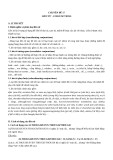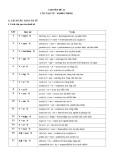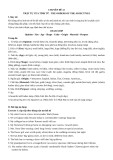
Tuyển tập Hội nghị Khoa học thường niên năm 2024. ISBN: 978-604-82-8175-5
574
FORMATIVE ASSESSMENT
IN ENGLISH LANGUAGE CLASSES
Le Thi Phuong Lan
Thuyloi University, email: lanltp@tlu.edu.vn
1. INTRODUCTION
Formative assessment is a pivotal educational
practice that has drawn the attention of
researchers and educators worldwide. It serves
as a teaching tool for both teachers and
students to increase the efficiency of the
learning process.
This study aims to examine the theory of
formative assessment and then offer some
activities related to formative assessment for
language teachers to apply in their classes.
2. RESEARCH METHOD
This is a qualitative literature review in
which the author synthesizes the materials
from all related papers on the topic of
formative assessment.
3. FORMATIVE ASSESSMENT VERSUS
SUMMATIVE ASSESSMENT
There are two broad categories of
assessment: formative and summative ones.
It is important to distinguish the two kinds of
teaching tools so that educators can utilize
each kind appropriately.
Formative assessment refers to an
instructional tool in which student achievement
is analyzed and used by three agents,
including the teachers, peers, and the student
to make better teaching decisions for the next
steps in the educational process (Black &
Wiliam, 2009). Formative assessment is an
“ongoing, dynamic” process that happens
before summative assessment during an
instructional unit (Chappuis, 2007). On the
other hand, summative assessment reflects
and evaluates students’ learning results at the
end of class (Chappuis, 2007).
4. BENEFITS AND DRAWBACKS OF
FORMATIVE ASSESSMENT
4.1. Benefits
According to Gikandi et al. (2011),
formative assessment can bring about many
advantages as follows:
4.1.1. Clear goals and objectives
Formative assessment helps teachers
identify their lesson goals more clearly. By
using this tool of teaching, teachers better
understand students’ confusions as the lesson
progresses. Therefore, they can adjust the
teaching techniques accordingly.
4.1.2. Data-driven decisions
Formative assessment facilitates data
collection, which is useful for making data-
driven decisions. Based on the data gathered,
the teacher will make sound decisions to help
students succeed.
4.1.3. Increasing student engagement
Students have opportunities to engage in
collaborative teaching and learning
environments by taking part in activities
related to formative assessment. By
connecting the learning goals to realistic
scenarios, teachers help foster students’
natural curiosity.

























